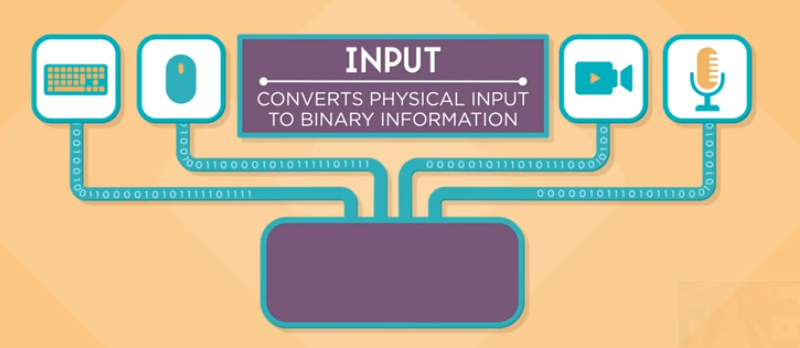Function of input/output devices
The
purpose of
input/output
devices:
- Humans and
computers
use
different ways
to represent
(the same) information
Example:
How humans represent the number TWO: 2
How computers represent the number TWO: ⚬⚬⚬⚬⚬⚬•⚬
(⚬⚬⚬⚬⚬⚬•⚬ represents the binary numbers 00000010 !!!)
|
-
Input/output devices
are used to provide a
human-friendly way
for:
- Humans to
interact with
a computer
|
|
The function of input devices
The function of
input devices:
- Input devices
enable human users
to
enter data
into the computer (= machine)
in a human-friendly way
- Input devices will
"translate"/convert the
human inputs into
binary numbers so
the computer can
store the
input data
|
Function of input devices - the keyboard
How humans
enter data into the
computer:
- typing
- pointing (mouse),
- speaking, etc...
|
E.g.:
The keyboard will
convert a
key press
into the binary representation of
the
character/letter:

|
(B is represented as
⚬•⚬⚬⚬⚬•⚬
inside the
computer)
|
- When the
user presses the
"B" key on the
key board, the
key board will
send ⚬•⚬⚬⚬⚬•⚬ (=01000010) to
the computer system
|
Note:
we will learn
how to
represent
letters in an alphabet
later in the course.
Other input devices
Operation of
4 commonly used
input devices:

- A
keyboard will
translate
the key press into
a binary number that
represents the
character on the
key
(and send the binary number to
the computer)
- A
mouse will
send
the
coordinates of the
current mouse position
as binary numbers to
the computer
- A
camera will
send
RGB signal values
(brightness levels of Red Green Blue)
- A
microphone will
send a
digitized audio signal
(amplitude value of the audio signal)
|
Function of output devices
The
output problem:
- Humans and
computers
use different ways
to represent (the same)
information
- How can a
computer
show/display the
stored information
(which is in binary)
to a human in a
human-friendly
manner ?
|
The function of
output devices:
- Output devices
enables
the computer to
show the
data stored inside the computer
to a
human user
in a
"human-friendly" way
|
Function of output devices -
illustrated
Recall that:
- The letter 'B' is
represented inside
the computer by
the
binary number ⚬•⚬⚬⚬⚬•⚬ (= 01000010)
|
Output devices
translates the
internal data representation
(which is a binary number) to
a human-friendly
representation.
Example: what will happen
when the computer send
⚬•⚬⚬⚬⚬•⚬ (= 01000010)
(which represents "B") to
the terminal:

Pixels on the
terminal display will be
turned on (= 1) or
turned off (= 0) to
show the
picture
B
❮
❯


